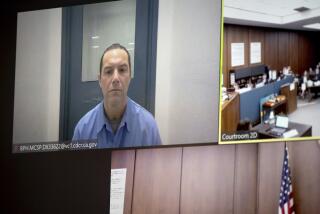Court Backs Use of DNA as Evidence : Crime: Appellate justices uphold decision that so-called ‘genetic fingerprinting’ is admissible, clearing the way for wider use.
VENTURA — For the first time in California, a state appeals court on Tuesday upheld the admissibility of DNA evidence, paving the way for widespread use of so-called “genetic fingerprinting” in court.
In a unanimous decision, a three-judge panel of the 2nd District Court of Appeal in Ventura ruled that DNA evidence was properly used in the 1989 robbery and murder conviction of a Ventura woman.
“This paves the way for prosecutors throughout California to utilize this evidence, both to convict the guilty and to clear the innocent,” Ventura County Dist. Atty. Michael D. Bradbury said.
Appeals court rulings are valid statewide unless another court of appeals issues a contrary ruling, in which case the state Supreme Court would decide the issue.
DNA evidence relies on a principle that has become widely accepted in the scientific community: that no two people have the same genetic coding. Experts can extract the genetic material known as DNA--or deoxyribonucleic acid--from hair, semen or skin particles left at a crime, and tell whether it matches DNA from a suspect.
DNA evidence has been used successfully in several criminal cases in Orange County.
In the Ventura County case, George White was found stabbed to death Feb. 24, 1988, at the downtown Ventura hamburger stand where he worked. Clutched in the dead man’s hand were several long, dark strands of hair, apparently ripped from the head of his attacker.
The defendant, Lynda Axell, who worked across the street from the burger stand, was immediately a suspect because she was seen driving away about the time of the murder. But the evidence against her was not conclusive, Deputy Dist. Atty. Carol J. Nelson said.
Nelson sent the hairs, plus samples of Axell’s blood, to Cellmark Diagnostics, a Maryland lab. Cellmark found that the DNA patterns of the blood and the hairs were identical. Lab officials said the odds that the hairs came from someone other than Axell were 1 in 6 billion.
To use the evidence at Axell’s trial, Nelson had to convince Ventura County Superior Court Judge Lawrence Storch that DNA evidence was accepted in the scientific community and that the probabilities cited by Cellmark were reasonable. After several hearings, Storch ruled that the evidence was valid, and he convicted Axell in a non-jury trial. She is serving a life sentence at the California Institution for Women at Frontera.
On Tuesday, in a 66-page opinion by Justice Steven J. Stone, the appeals court upheld Storch’s findings.
Nelson noted that because of the ruling, prosecutors no longer will have to go through lengthy hearings in each case to establish the validity of DNA evidence.
“I’m overjoyed,” Nelson said. “The people who should be jumping up and down are the innocent, who are not going to run the risk of being misidentified.”
But Axell’s attorney, James Matthew Farley, said he still has doubts about genetic evidence. He said he questions the validity of probability estimates, such as the 1-in-6-billion odds cited in the Axell case.
“In my opinion, this is not ready to come to court. It’s too soon,” Farley said of DNA evidence. He also pointed to the fact that Cellmark and other genetic labs are businesses and he challenged their impartiality.
The cost of the testing--about $13,000 in the Axell case--was once considered prohibitive in most cases, but Bradbury said the FBI is providing free DNA testing for local agencies.
More to Read
Sign up for Essential California
The most important California stories and recommendations in your inbox every morning.
You may occasionally receive promotional content from the Los Angeles Times.










